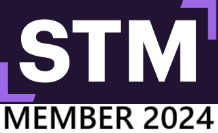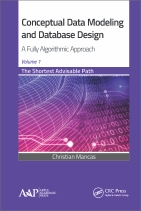|
|
Computer Science & Information Management
Reviews Named by BookAuthority.org as one of the
“What Christian Mancas wanted to do is to write the best possible book on real, pragmatic database design available, bar none. He succeeded. This book will find its way into the literature on database design and development. It has a good number of ideas that must be considered in any design task. It uses a sample-based approach and is thus easy to understand. It supports digestion due to nice exercises. And, finally it discusses in details also the result of a design in different DBMS languages. So, a reader can be sure that the book guides to the right track.” —Bernhard Thalheim, Department of Computer Science, Christian-Albrechts-University Kiel, Germany (from the Foreword) “Covers the classical data management topics that any computer professional should master. . . . This volume is a gentle yet rigorous and extensive introduction to the main topics in data management, with concrete examples on several popular database systems. There are lots of detailed examples, and each concept is covered in detail, and from several perspectives, using alternative definitions or notations where needed. The book ensures that no reader is left behind, and all potential questions are answered. . . . Best suited for the practitioner who wants to achieve a thorough understanding of the fundamental concepts in data management. . . . This volume as an important first step in understanding the complexities of data today.” —Dan Suciu, Professor, University of Washington, Seattle, USA (from the Foreword) “Modern scientific and business challenges, the proliferation of personal computers and intelligent gadgets, the Internet and industries’ large amounts of data, all fuel a huge need of database management systems. The book by C. Mancas is an excellent introduction to pragmatic database design and development. Presented in a gentle manner, with many examples, the book is suited to a large category of readers, from computer science and engineering students to the practitioners of the domain.” —Cristian S. Calude, Chair Professor, Department of Computer Science, University of Auckland, New Zealand “One of the biggest problems in nowadays applications is the management of data. Analyzing and structuring large amounts of data relies on understanding and being able to describe its properties and constraints. Professor Christian Mancas’s exceptionally well-documented work, Conceptual Data Modeling and Database Design, gives the basic insights of the database models and their importance as a foundation for the complex applications. This book guides the reader throughout real-life scenarios, providing essential software engineering advice. Indeed, by addressing some of the problems people usually encounter when designing a database, Professor Mancas pedagogically connects the end user’s requirements to the notions of entities and relations between them. Meanwhile, the mathematical analysis and proofs sustain the theoretical background of the statements and provide a complete view of the possible algorithmic optimizations. The first volume, A Fully Algorithmic Approach: The Shortest Advisable Path, represents an important contribution in the learning process as it advocates best practice rules in database designs with clear explanations and practical exercises. This first volume mainly presents Professor Mancas’s point of view of the database design state of the art (enriched with his main original contributions to the E-RDM and RDM). I am looking forward for the second volume of this book that will mainly present his most important contribution to the conceptual data modeling and database design: his (Elementary) Mathematical Data Model [(E)MDM], as well as MatBase, his KDBMS prototype based on both (E)MDM, E-RDM, RDM, and Datalog.” —Andra Hugo, PhD, University of Bordeaux, France ”According to the prestigious BookAuthority.org (https://bookauthority.org/author/Christian-Mancas), this book is a winner in the following 16 categories: Data Modeling, Database Design, Database Theory, Relational Databases, Database Schema, Databases, Data Processing, and Algorithms, for both Beginners and All Time, Its readers mostly appreciate its pragmatic, gentle, pedagogical, and algorithmic approach, its valuable knowledge and best practice rules, as well as its real-life examples and fully presented case studies.” Now Available in Paperback This book aims to provide to both beginners and experts with a completely algorithmic approach to data analysis and conceptual modeling, database design, implementation, and tuning, starting from vague and incomplete customer requests and ending with IBM DB/2, Oracle, MS SQL Server, or Access based software applications. A rich panoply of solutions to actual useful data sub-universes (e.g. business, university, public and home library, geography, history, etc.) is provided, constituting a powerful library of examples. Four data models are presented and used: the graphical Entity-Relationship, the mathematical EMDM, the physical Relational, and the logical deterministic deductive ØDatalog. For each one of them, best practice rules, algorithms, and the theory beneath are clearly separated. Four case studies, from a simple public library example to a complex geographical study, are fully presented, on all needed levels. Many real-life exercises are proposed, several of which in each chapter are completely solved. Both major historical and up-to-date references are provided for each of the four data models considered. The book provides a comprehensive set of best practice rules, a library of useful solutions to real-life problems, and other valuable knowledge on data analysis and modeling, database design, implementation, and fine tuning. CONTENTS: About the Authors / Editors: Christian Mancas, PhD Associate Professor, Mathematics and Computer Science, Ovidius State University, Constanta, Romania; invited Associate Professor, Engineering Taught in Foreign Languages Department (Computer Science and Telecommunications in English stream), Politehn Christian Mancas, PhD, is currently an Associate Professor with both the Mathematics and Computer Science Department of Ovidius University, Constanta, Romania, and the Engineering Taught in Foreign Languages Department (Computer Science and Telecommunications in English stream) of Politehnica University, Bucharest, Romania (as an invited Professor). Since 2012, he is also a database architect with Asentinel International srl, Bucharest, a subsidiary of Asentinel LLC, Memphis, Tennessee. His specialties include university teaching, R&D, business analysis, conceptual data and knowledge modeling and querying, client-server, hierarchical software architecture, object-oriented, event-driven design, structured development, complex project and small IT company management, Datalog, SQL, C#, XML programming, etc. Professor Christian Mancas has published dozens of scientific papers (in Romania, USA, Austria, and Greece), which have been indexed by ACM Digital Library, Zentralblatt, Scopus, DBLP, Arnetminer, Researchr, TDGS, SCEAS, etc. He has also published three books in Romanian and dozens of reviews (mostly in USA, including ACM Reviews). He was a Program Committee member and session chairman for several software conferences in USA, Austria, and Romania, and he is a member of several associations (including ACM, the Romanian Mathematics Sciences Society, and the International Who’s Who of Professionals), and an editor of the Journal of Information Technology and Software Engineering (JITSE, USA). Since 2006, his biography is included in Marquis Who’s Who in the World and Who’s Who in Science and Technology and Hubners’ Who’s Who in Romania. Since 1990, he also worked for several IT startups, including his own DATASIS Consult srl (co-owned with his good friend and faculty colleague Ion Draghicescu) and DATASIS ProSoft srl (who had 25 programmers working for the design and development of several ERP-type database applications for customers from France, UK, Switzerland, USA, Israel, Greece, and Romania). His main research areas are the conceptual data and knowledge modeling and querying; database design, implementation, and optimization; as well as the architecture, design, development, fine-tuning, and maintenance of data and knowledge base management systems. Dr. Mancas has graduated in 1977 the Computers Department of Politehnica University of Bucharest, Romania, with a thesis on Generating Parsers for LR(k) Grammars, under the supervision of Professor Dan Luca Serbanati. Up until the fall of communism in 1990, he worked as a software engineer and, since 1980, R&D manager of a state-owned Computer Center in Bucharest (contributing to the design, development, and maintenance of a dedicated ERP), also conducting (from time to time) computer programming labs at Politehnica University of Bucharest, but, for political reasons, he was not accepted for PhD studies. He started this program under the supervision of Professor Cristian Giumale in 1992 and obtained his PhD degree in 1997 from the same as above department, with a thesis on Conceptual Data and Knowledge Modeling. |

 Follow us for the latest from Apple Academic Press:
Follow us for the latest from Apple Academic Press:
New Book Series: AAP Advances in Materials, Manufacturing & Computational Intelligence Techniques plans to offer a comprehensive exploration of cutting-edge research and applications in various engineering and scientific fields. This multidisciplinary series caters to a wide range of readers, from researchers and academics to industry professionals, providing in-depth knowledge and practical insights into solving complex problems. The series explores into a diverse array of topics, including advanced materials, manufacturing techniques, and computational intelligence. For more information, visit:
Click here
AAP WELCOMES PROF. MOHAMMED KUDDUS, PhD, AS AAP’S NEW ACQUISITIONS EDITOR for books on biotechnology, enzymology, microbiology, bioinformatics, bioremediation, biomedical technology, value-added products etc. Dr. Kuddus is Head of the Department of Biochemistry at the College of Medicine, University of Hail, Kingdom of Saudi Arabia. He is listed in Elsevier/Stanford University World’s Top 2% Scientists. He seeks book proposals from potential editors to consider for publication with Apple Academic Press. Contact: kuddus@appleacademicpress.com for more information. AAP welcomes Dr. Maulin P. Shah as AAP’s new acquisitions editor for books on Applied Microbiology, Environmental Biotechnology and Waste Management. Dr. Shah, a Scientist in the Industrial Wastewater Research Lab at Enviro Technology Ltd., India. seeks book proposals to consider for these topics and related areas: applied microbiology, environmental biotechnology and waste management, including environmental pollution, wastewater treatment, bioenergy, biofuel, circular economy, leachate treatment activated sludge process, environmental microbiology, agricultural microbiology, advance oxidation process, bio-electrochemical systems, bacterial genomics for wastewater treatment, and heavy metal remediation. maulinshah1979@gmail.com for more information. AAP is pleased to announce Shrikaant Kulkarni, PhD, as our new Senior Commissioning Editor for books in the areas of Polymer Sciences, Chemical Sciences, Nuclear Sciences, and Material Sciences. Dr. Kulkarni is Adjunct Professor, Faculty of Business, Victorian Institute of Technology, Melbourne, Australia; and Adjunct Professor, Centre of Research Outcome and Impact, Chitkara University, Punjab, India. You can reach him at Email: srkulkarni21@gmail.com for more information. New Book Series: AAP Series on Waste Biomass Valorization will explore the transformation of biomass resources into valuable products, addressing the growing need for sustainable alternatives to fossil fuels and non-renewable resources. For more information and to propose a book, please visit: Click here Congratulations to Hafiz Ansar Rasul Suleria, PhD, for receiving the Dean’s Award for Excellence in Research from the University of Melbourne, Australia, in recognition for his exceptional performance and strong commitment to advanced research in food science. Dr. Suleria is editor of AAP’s book series Innovations in Plant Science for Better Health: From Soil to Fork. For more information, visit: Click here Congratulations to Dr. Christian Mancas. His book Conceptual Data Modeling and Database Design: A Fully Algorithmic Approach was one of the 6 Best Data Modeling ebooks for Beginners by BookAuthority, a leading site for book recommendations. For more information, visit: Click here COMMENTS FROM AAP EDITORS AND AUTHORS AAP book title: Advances in Audiology and Hearing Science (2-volume set) “I have collaborated with AAP during the process of bringing my two-volume editing work to a final publishing phase. AAP support has been truly important throughout the initial and final stages of the book. While the majority of the publishing work is done at the early stages, the final touches that include the last-minute corrections of the authors are extremely crucial to the quality the book tries to convey. The assistance of AAP during the last stages of corrections and communication with the authors was a very positive contributor to my state of mind during those stressful moments. I recommend the publishing experience with AAP to other editors of scientific material.” —Stavros Hatzopoulos, PhD, Hearing Science Laboratory, University Hospital of Ferrara, Ferrara, Italy AAP book title: Nanotechnologies: The Physics of Nanomaterials (2-volume set) “I was very pleased with the interaction and support of the team at Apple Academic Press. They provided me with regular and useful information and updates throughout the publishing procedure. I am also very happy with the final product, which is of good quality. The books are now available and are professionally distributed through the various channels. I would like again to thank the team at AAP for all their hard work and support.” —David Schmool, PhD, Director, Groupe d’Etude de la Matière Condensée GEMaC, National Centre for Scientific Research, Université de Versailles/Saint-Quentin, Université Paris-Saclay,Versailles, France AAP book title: Physiology of Molluscs (2-volume set) “I have enjoyed the full benefit of support, encouragement, and kindness from the members of AAP I have had the pleasure of being associated with. In the same vein, I hope AAP was satisfied with the book series I have edited in advancing the knowledge. It has been a great journey and was a great pleasure and satisfaction. Advancing scholarship through publications is one of the best routes publishers can take, and I would hold AAP as one of the best ones.” —Saber Saleuddin, PhD, University Professor Emeritus, Department of Biology, York University in Toronto, Ontario, Canada AAP book title: Green Chemistry and Sustainable Technology: Biological, Pharmaceutical, and Macromolecular Systems “It had been my pleasure to work with the production team of Apple Academic Press for almost a decade. The best presentation of our work was due to their hard work and with careful scrutiny. I am sure that every one of them takes extra pains to publish the book nicely, maintaining the quality and timeliness. It was a rewarding experience to work with AAP. I would like to publish more with AAP on my upcoming projects in future also.” —Prof. Suresh C. Ameta, Professor of Eminence (Distinguished Professor), Faculty of Science, PAHER University, UDAIPUR, India AAP book title: New Frontiers in Nanochemistry, 3-volume set, plus many others "Publishing a book, either as author or editor, is a journey from the initial vibration to the piece of knowledge towards the present future of humanity at large. Such a journey is about climbing and tunneling, about diving and driving through, about inspiration and tuning, about hard working in every instance; and it is also about time. Very few Global Publishers have the wisdom and patience and kindness and openness to authors, contributors, and readers while being truly crafting oriented as Apple Academic; yet all is about people and their education, vision and assumed mission; the Apple Academic Team heartily succeed that in achieving the world class scholarly acclaim by the quality involvement in all chain of plus value added with each publishing event. Hearty Compliments! Excelsior Apple Academic!" —Mihai V. Putz, PhD, Dr.-Habil., MBA, Professor, Faculty of Chemistry, Biology, Geography, Laboratory of Computational and Structural Physical Chemistry for Nanosciences and QSAR, West University of Timi?oara; PI-1, Laboratory of Renewable Energies - Photovoltaics, National Research and Development Institute for Electrochemistry and Condensed Matter (INCEM), Timi?oara, Romania AAP book title: The Chemical Century: Molecular Manipulation and Its Impact on the 20th Century “All my experiences with AAP have been very positive. I entrusted AAP with the publication of The Chemical Century: Molecular Manipulation and Its Impact on the 20th Century and found the quality of the book that they produced to be excellent. My two contacts at the company were very responsive and efficient throughout the publication process.” —Richard J. Sundberg, PhD, Professor of Chemistry, University of Virginia, Charlottesville, Virginia, USA AAP book titles: Medical Tourism and Wellness: Hospitality Bridging Healthcare (H2H)© and Medical Travel Brand Management: Success Strategies for Hospitality Bridging Healthcare (H2H) “I have enjoyed my scholarly creative work with Apple Academic Press. They have been timely, creative, and very helpful for my two books with them. I encourage you to consider publishing your work with AAP.” —Frederick DeMicco, PhD, RDN, Executive Director and Professor School of Hotel and Restaurant Management, Northern Arizona University, Flagstaff, Arizona AAP book title: The Chemical Evolution of Phosphorus: An Interdisciplinary Approach to Astrobiology “I’m very pleased with the books you have edited. It shows a very good and careful work by everyone involved along the whole production process, and so the final result is a beautiful piece: it has come out as a very nice and appealing book, easy to handle and read, .... and hopefully of interest for people from diverse related fields!” —Enrique Macia-Barber, PhD, Professor of Condensed Matter Physics, Universidad Complutense de Madrid, Spain |



